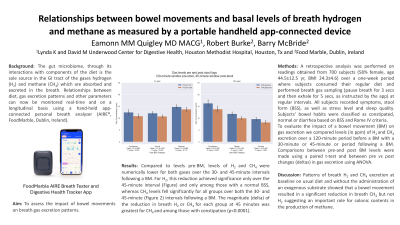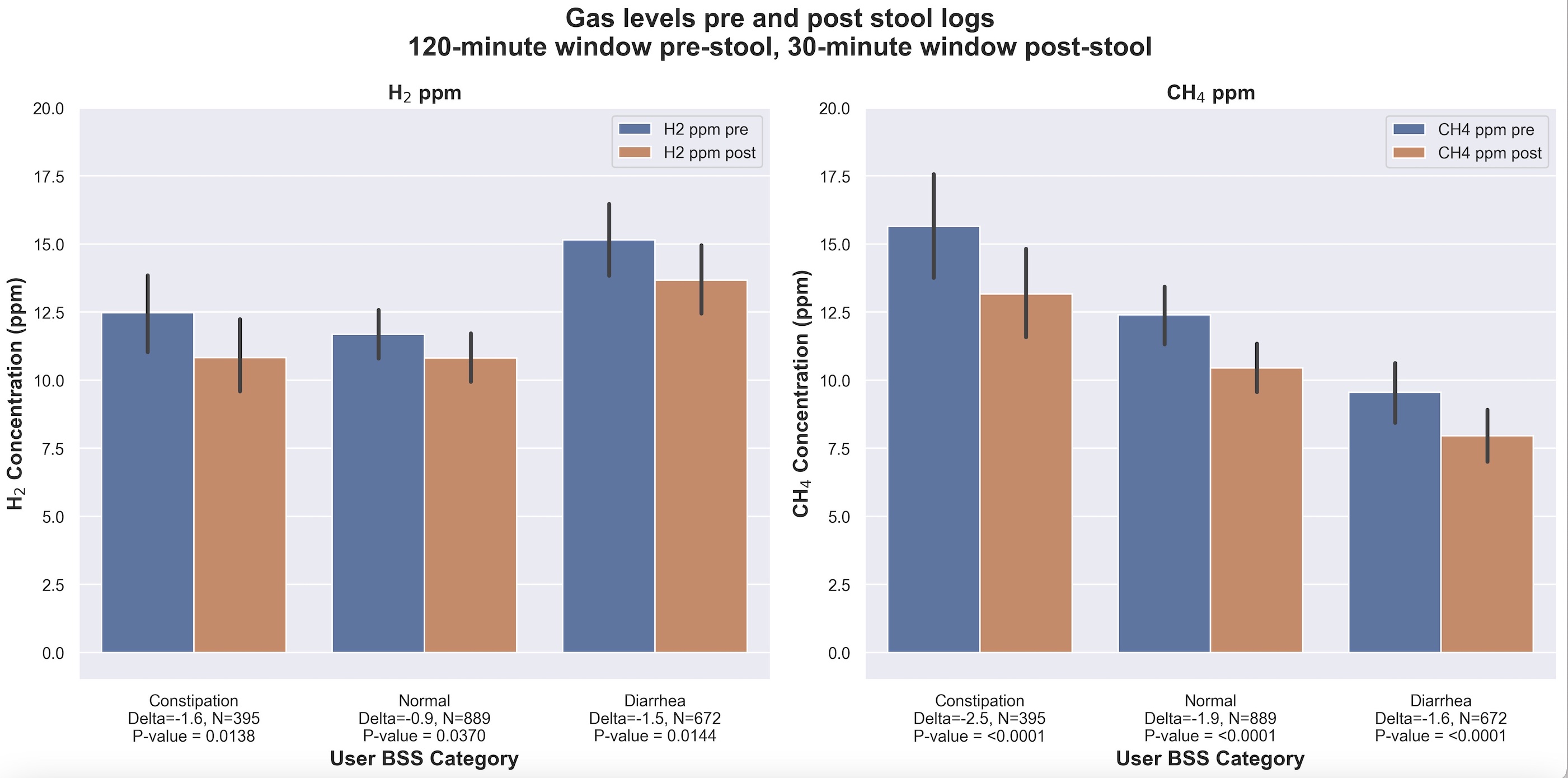Monday Poster Session
Category: Functional Bowel Disease
P2341 - Relationships Between Bowel Movements and Basal Levels of Breath Hydrogen and Methane as Measured by a Portable Handheld App-Connected Device
Monday, October 28, 2024
10:30 AM - 4:00 PM ET
Location: Exhibit Hall E

Has Audio
- EQ
Eamonn Quigley, MD
Houston Methodist Hospital
Houston, TX
Presenting Author(s)
Eamonn Quigley, MD1, Robert Burke, MSc2, Barry McBride, MSc3
1Houston Methodist Hospital, Houston, TX; 2FoodMarble Digestive Health Ltd., Tipperary, Tipperary, Ireland; 3FoodMarble Digestive Health Ltd., Dublin, Dublin, Ireland
Introduction: The gut microbiome, through its interactions with components of the diet is the sole source in the GI tract of the gases hydrogen (H2) and methane (CH4) which are absorbed and excreted in the breath. Relationships between diet, gas excretion patterns and other parameters can now be monitored real-time and on a longitudinal basis using a hand-held app-connected personal breath analyzer (AIRE®, FoodMarble, Dublin, Ireland). Our goal was to study the impact of bowel movements on breath gas excretion patterns.
Methods: A retrospective analysis was performed on readings obtained from 700 subjects (58% female, age 44.5±12.5 yr, BMI 24.3±4.6) over a one-week period where subjects consumed their regular diet and performed breath gas sampling (pause breath for 3 secs and then exhale for 5 secs, as instructed by the app) at regular intervals. All subjects recorded symptoms, stool form (according to Bristol Stool Scale - BSS), as well as levels of stress and sleep quality throughout. Subjects’ bowel habits were classified as constipated (n=170), normal (326) or diarrhea (204) based on BSS and according to Rome IV criteria. To evaluate the impact of a bowel movement (BM) on gas excretion we compared levels (in ppm) of H2 and CH4 excretion over a 120-minute period before a BM with a 30-minute or 45-minute or period following a BM. Where paired data were available pre-and post BM levels were compared paired t-test.
Results: From the 700 subjects 395, 889 and 672 paired pre- and post-BM levels were available at the 30-minute interval and 582, 1322 and 967 at the 45-minute interval from subjects with constipation, a normal bowel habit and diarrhea, respectively. Compared to pre-BM, levels of H2 and CH4 were significantly lower for both gases over the 30- and 45-minute intervals following a BM with the reductions being greatest during the 30-minutes window (Figure). The magnitude (delta) of the reduction in breath H2 or CH4 for each group at both 30 and 45 minutes was greatest for CH4 and among those with constipation (p< 0.0001).
Discussion: This study which examined patterns of breath H2 and CH4 excretion at baseline and without the administration of an exogenous substrate and on each individual’s habitual diet. A bowel movement resulted in a significant reduction in H2 and CH4 excretion. suggesting an important role for colonic stool content in the production and excretion of gases and of methane, in particular.

Disclosures:
Eamonn Quigley, MD1, Robert Burke, MSc2, Barry McBride, MSc3. P2341 - Relationships Between Bowel Movements and Basal Levels of Breath Hydrogen and Methane as Measured by a Portable Handheld App-Connected Device, ACG 2024 Annual Scientific Meeting Abstracts. Philadelphia, PA: American College of Gastroenterology.
1Houston Methodist Hospital, Houston, TX; 2FoodMarble Digestive Health Ltd., Tipperary, Tipperary, Ireland; 3FoodMarble Digestive Health Ltd., Dublin, Dublin, Ireland
Introduction: The gut microbiome, through its interactions with components of the diet is the sole source in the GI tract of the gases hydrogen (H2) and methane (CH4) which are absorbed and excreted in the breath. Relationships between diet, gas excretion patterns and other parameters can now be monitored real-time and on a longitudinal basis using a hand-held app-connected personal breath analyzer (AIRE®, FoodMarble, Dublin, Ireland). Our goal was to study the impact of bowel movements on breath gas excretion patterns.
Methods: A retrospective analysis was performed on readings obtained from 700 subjects (58% female, age 44.5±12.5 yr, BMI 24.3±4.6) over a one-week period where subjects consumed their regular diet and performed breath gas sampling (pause breath for 3 secs and then exhale for 5 secs, as instructed by the app) at regular intervals. All subjects recorded symptoms, stool form (according to Bristol Stool Scale - BSS), as well as levels of stress and sleep quality throughout. Subjects’ bowel habits were classified as constipated (n=170), normal (326) or diarrhea (204) based on BSS and according to Rome IV criteria. To evaluate the impact of a bowel movement (BM) on gas excretion we compared levels (in ppm) of H2 and CH4 excretion over a 120-minute period before a BM with a 30-minute or 45-minute or period following a BM. Where paired data were available pre-and post BM levels were compared paired t-test.
Results: From the 700 subjects 395, 889 and 672 paired pre- and post-BM levels were available at the 30-minute interval and 582, 1322 and 967 at the 45-minute interval from subjects with constipation, a normal bowel habit and diarrhea, respectively. Compared to pre-BM, levels of H2 and CH4 were significantly lower for both gases over the 30- and 45-minute intervals following a BM with the reductions being greatest during the 30-minutes window (Figure). The magnitude (delta) of the reduction in breath H2 or CH4 for each group at both 30 and 45 minutes was greatest for CH4 and among those with constipation (p< 0.0001).
Discussion: This study which examined patterns of breath H2 and CH4 excretion at baseline and without the administration of an exogenous substrate and on each individual’s habitual diet. A bowel movement resulted in a significant reduction in H2 and CH4 excretion. suggesting an important role for colonic stool content in the production and excretion of gases and of methane, in particular.

Figure: Gas levels pre (120-minute window) and post (30-minute window) bowel movement.
Disclosures:
Eamonn Quigley: Atmo Biosciences – Advisor or Review Panel Member, Consultant, Grant/Research Support. Cindome – Grant/Research Support. Food Marble – Consultant. Nimble – Consultant. Novozymes – Consultant. Takeda – Grant/Research Support. Vibrant – Advisor or Review Panel Member, Consultant, Grant/Research Support. Vibrant Advisory Board – Advisory Committee/Board Member.
Robert Burke: FoodMarble Digestive Health – Employee.
Barry McBride: FoodMarble Digestive Health – Employee.
Eamonn Quigley, MD1, Robert Burke, MSc2, Barry McBride, MSc3. P2341 - Relationships Between Bowel Movements and Basal Levels of Breath Hydrogen and Methane as Measured by a Portable Handheld App-Connected Device, ACG 2024 Annual Scientific Meeting Abstracts. Philadelphia, PA: American College of Gastroenterology.

